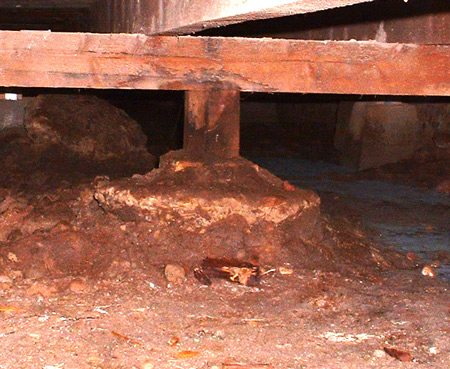Rant
Larry’s Rant #6
I didn’t get up today expecting it would be such a perfect day for writing a rant. Another day in paradise, as we say in San Diego. Rain is expected, which is a good thing in drought-ridden California, but generally pretty rare. If you have read my other rants you know I like rain, because it causes the ground to move, concrete to wear, and dollar signs to appear in the foundation contractor’s eyes. Of course it is the homeowner’s enemy, so check out my advice in my other rants. However, that isn’t the reason I am writing today. I have covered that before, and frankly, I talk about water so much sometimes it makes me have to pee. It’s just that sometimes things come up, and I realize that the mess I am involved today might shed light enough to help others avoid the problems in the future.
Today, I have three great examples of foundation problems. Not the actual foundation problems themselves. These are problems resulting from poor decisions or unfortunate circumstances. The “normal” estimate/job process is: The client calls me up, maybe they are buying a house, maybe they have owned it for awhile, then I look it over, send them an estimate, then they call me up “Hey Larry, send me a contract, come fix my house!” kind of normal stuff. No, what I am talking about is the problem with a client fixed, or rather, didn’t fix the problem. And now the foundation problem has become a financial problem.
The first example is a guy who bought a house about three years ago, and supposedly the previous owner had it fixed by a contractor. He told me the name of the contractor, but I will just say it’s someone well known in town that does work similar to mine (note the choice of the word “similar”). Anyway, the problem is the posts and piers were old and worn out, and the perimeter foundation had a number of vertical cracks. This is what I call “bread and butter” type stuff for us-we see and fix these all the time. Typical 1920’s house, without a concrete perimeter foundation that isn’t completely worn out, but the posts and piers are worn out or have major issues, and the perimeter has some vertical cracks. So, the proper repair of the posts and piers is to support the beams, remove the old piers, start one foot from the end of the beam, and install piers every 4 feet, as well as under every split in the beam (where the beam comes together end to end, like a kiss). Standard, by the book, by current code stuff. So what does the contractor do? Put new piers in-but between the old piers, leaving the old worn out piers in place. Puts the first pier right next to the old pier, about 4 feet from the beam-ends. Doesn’t remove the piers at the beam splits, just add one next to it. Is this right? Kinda…maybe, but no, not really. Because now the home inspector points brings up the issue of how the beam ends are not supported, and how the original piers are old and should be replaced, and it’s a big issue. Of course the other issue is the vertical cracks. These the contractor epoxy injected. Working just fine except….he missed repairing at least three of them. So they need to be fixed. This is a minimum $3,000 bid from me, just to fix a problem that was supposedly already addressed. What about removing the old piers, etc.? That’s more. Really not the client’s fault, but then again, who hired this Yahoo? Who inspected this work? Are they standing behind their work? (You know the answer here is no). The upshot-client can’t sell his house without fixing the problem or lowering the selling price.
One of these calls any given day is not unusual. But wait-there is more!
Problem two-I get a call from a guy I gave an estimate for four years ago. Seems he had a post and pier system that was also in bad shape. Not his doing-he bought the house that way. This is a little different-new piers installed without poured footings (not code!), no posts and only shims and blocks, and several missing posts. Some minor cracks in the stemwalls-more bread and butter! (Did I mention I like bread and butter?) Did nothing for three years (he really should have fixed it then….) and now he is in escrow. The buyer really likes the house, and wants to buy it if it has no major foundation problems. No worries, right? Wrong! He calls me because they had a home inspection (disclosure anyone?), and the buyer brought in another contractor. The contractor wants to replace the perimeter foundation, even though the wear is pretty minor, and it looks to have lots of life left. Is he wrong? I think so. But now we have a conflict, and an engineer needs to come in and “break the tie”. I am fine with that, but that’s $600 gone (not my money!), and likely additional requirements and paperwork. Worst case is the engineer says, “Replace the whole thing” and now your $10k problem just became a $50k problem. As my wife says when I do something stupid (daily) “That’s what you get!”. Still waiting to see how this one turns out.
Thought that was enough for one day, but here is my doozy. Got a call a couple days ago from a real estate agent. The sellers of a property had received a quote from me a few months back to replace the posts and piers. They forward my quote, and say to the buyers that the work is getting done, starting this week. So he calls me with some questions about the work. “What job?” I say. I am actually doing a job almost across the street. So I am a bit confused (doesn’t take much) until I get to my computer and find out that I am not doing that job, I had only done an estimate and never heard anything. So I called him back and tell him, and he says he will call the selling agent and let me know. Turns out that the sellers have another contractor (who I have never heard of) doing the job. Just a “misunderstanding”. Fine with me-as long as I don’t have to do a warranty repair on someone else’s work. So of course, he calls me back today, because the deal is going to fall through. For some reason, the contractor has poured the piers, but says they can’t set the piers for 10 days. Huh? Are they building a new baseball stadium? I have put posts on piers poured the next day for the last 20 years. I later asked an engineer friend about it and he confirmed they don’t need to wait. How convenient that they can’t set the posts till after the contingency period is over. This is fishy, of course, and with all the shenanigans up ’til now the buyers have no faith or trust in the sellers that the work will be done well, let alone finished correctly. So, as a favor (and because I am curious) I get to go by tomorrow to check it out. I can’t write a report (I am not an engineer or inspector) but as you can imagine I will be, well, a little anal about what I see. If they are not 4’ apart as required by code (4’ 1”? repour!) or something else is wrong, they will know about it. Really, it will be a shame to take my frustration out on some poor schlub contractor. But, take the good name of Craftsman Foundation Repair and use it to deceive or confuse a client and somebody is going to bear the burden. It may be the work is done just fine, but I ain’t betting on it!
So what’s the point? I don’t expect people to change their behavior completely. I am not that naïve. I just assume that people who read my rants care about their house, their foundation, and their pocketbook. Foundation work is not really that complicated, nor something really we want to deal with, but sometimes how people deal with a problem can have a huge effect on the bottom line, and can make what I consider simple decisions really complicated. I hope if I point out some of the pitfalls you might be able to step around them.









Leave a reply